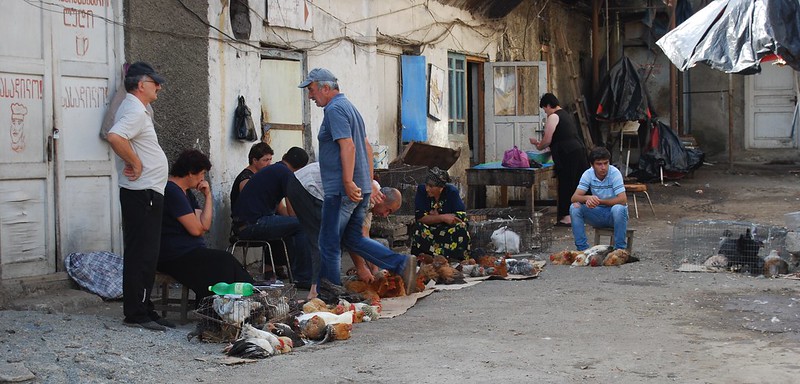Everything You Need to Know About Poverty in Azerbaijan
 Azerbaijan’s economic landscape, which it’s energy sector significantly shaped, stands at the crossroads of prosperity and disparity. In order to delve into the intricacies of poverty in Azerbaijan, it is crucial to understand the broader context of its political economy and the role it plays regionally. This article combines insights into poverty issues with a comprehensive overview of Azerbaijan’s economic sectors and regional significance, as well as successes in alleviating poverty in Azerbaijan through government initiatives.
Azerbaijan’s economic landscape, which it’s energy sector significantly shaped, stands at the crossroads of prosperity and disparity. In order to delve into the intricacies of poverty in Azerbaijan, it is crucial to understand the broader context of its political economy and the role it plays regionally. This article combines insights into poverty issues with a comprehensive overview of Azerbaijan’s economic sectors and regional significance, as well as successes in alleviating poverty in Azerbaijan through government initiatives.
Background on Poverty and Inequality in Azerbaijan
In Azerbaijan, as of 2021, 5.9% of the population lived below the National Poverty Line, and the total unemployment rate stood at 6%. While absolute poverty has decreased in the country over successive decades, concerns persist regarding relative poverty and perceived inequality. Rural-urban disparities contribute significantly. It was reported that in 2009, there were notable gaps in access to gas supply and sanitation between urban and rural areas.
Gender disparities and a rigid political landscape further complicate Azerbaijan’s social fabric, as women bear the burden of unpaid care work and face higher unemployment rates. The political elite’s focus on energy and security issues, rather than democratic values, poses challenges to broader societal inclusion. These complex challenges highlight the need for comprehensive strategies addressing economic and social dimensions of poverty in Azerbaijan.
The Resource Dilemma
Baku’s architectural grandeur echoes the wealth derived from the oil and gas sector, constituting 91% of total exports in 2022. The PSA (Production-Sharing Agreement) of 1994, known as the “Contract of the Century,” has been pivotal in Azerbaijan’s economic trajectory. However, this wealth has not seamlessly trickled down, leaving citizens outside Baku grappling with financial challenges and underscoring the need for equitable wealth distribution. Notably, as of 2022, the top 10% of earners commanded 674 manats per month, while the bottom 10% struggled with an income of 183.4 manats per month, illustrating stark economic disparities.
Consumer Confidence and Economic Sentiments
While urban-rural disparities persist, a deeper analysis of the Consumer Confidence Index (CCI) reveals pessimism among respondents about the country’s economic trajectory. Negative sentiments and a lack of transparency result in calls for policy reforms to restore confidence in government economic strategies. Results from a study with 500 participants in 2022 indicate that 44% mentioned worsening financial circumstances in the past 12 months, 80% believed the country’s economy deteriorated and 96% observed an increase in prices. Regarding future expectations, 28% predicted worse financial conditions in the next 12 months, 61% thought the country’s economic state would worsen and 81% anticipated rising prices.
Regional Economic Dynamics
Looking at the broader picture, Azerbaijan’s economic influence transcends its territorial confines. The transformative deal of 1994, focusing on oil resources, catapulted Azerbaijan into a regional economic powerhouse, leaving an enduring impact on key sectors like transportation and energy infrastructure. In the wake of this ground-breaking agreement, defining regions and skillfully managing relationships became even more critical, adding layers of complexity to the quest for sustained economic stability.
Azerbaijan’s strategic alliances, notably with Turkey, play a pivotal role in its economic narrative. Potential threats arise from political challenges in pipeline transportation routes, making it crucial to balance mutual dependence while managing socio-economic relations for sustainable economic routes and regional leadership.
Positive Progress in Poverty Alleviation
Azerbaijan’s robust state initiatives, including the ‘National Programme on Women’s Issues‘ and the ‘State Strategy on the Development of Education,’ have yielded substantial progress in poverty alleviation. The ASAN Service, recognized with the UN Public Service Award, significantly streamlined public services.
Notable successes include Azerbaijan being considered a high human development nation since 2010, and from 2003 to 2015, the country saw a decline in women’s unemployment from 12.7% to 5.9%; a 100% literacy rate among 15-24 year-olds; and a reduction in the absolute poverty rate from 49% to 4.9%. The State Statistical Committee reported a significant decrease in the poverty rate from 61.5% in 1995 to 4.8% in 2019, highlighting the nation’s commitment to addressing poverty challenges.
Looking Ahead
As poverty in Azerbaijan continues to pose problems, the state simultaneously grapples with its role as a regional economic powerhouse. The PSA’s impact on the energy sector, while monumental, necessitates economic diversification and a move toward a comprehensive modern economy.
Turkey’s economic transformation could serve as a source of inspiration for Azerbaijan. The call to diversify sectors, import technologies and exchange expertise sets the stage for long-term economic trends. The transition to a knowledge-based economy, geopolitical savvy, and societal inclusivity could unlock a future where Azerbaijan thrives as a model of economic resilience and regional cooperation.
–Arshiya Eslamdoust
Photo: Flickr
